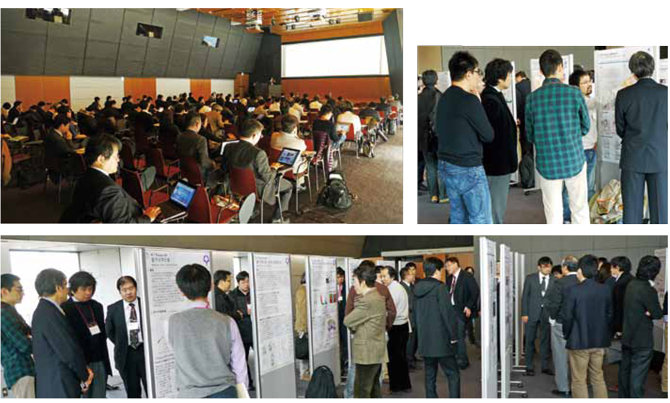
ISLiM Interim Accomplishment Meeting in 2011
Computational Science Research Program, RIKEN
Eietsu Tamura
The Next-Generation Integrated Simulation of Living Matter (ISLiM) program held an Interim Accomplishment Meeting in 2011 at Takeda Hall in the University of Tokyo on December 21 (Wed) and 22 (Thu), 2011.
ISLiM program was launched in October 2006 along with the development of the K computer, with the aim to understand life phenomena more deeply and to contribute to drug discovery and healthcare in particular. It remains one year to go before completion of this program. The researchers of 14 universities and institutes have been making collaborative efforts to develop ISLiM software and optimize them for the K computer. ISLIM develops 33 homegrown application programs, and challenges the most efficient, large-scale, and highly accurate simulation with K computer. A total of 141 researchers specializing in life sciences and healthcare from industry and academia attended the ISLiM Interim Accomplishment Meeting in 2011, where ISLiM software developers reported their latest results for two days.
First, Koji Kaya, Director of the Computational Science Research Program, gave an opening speech. Then, Ryutaro Himeno, Deputy Program Director of the program, explained the current status for development of application software, each of which has been optimized by using the K computer in trial operation from March or April 2011, and showed interim performance data. Himeno said, "Our efforts will be focused on optimization of ISLiM sof t ware until November 2012 when K computer becomes generally available. The performances for some software products (cppmd, ZZ-EFSI) have reached to 20-30% of the peak performance of the K computer. Further efforts will be directed to improvement of performance and to dissemination of the software."
Afterwards, the leaders of the six ISLiM teams (Molecular Scale Team, Cell Scale Team, Organ and Body Scale Team, Data Analysis Fusion Team, Brain and Neural Systems Team, and High-performance Computing Team) and ISLiM's researchers in charge of development of ISLiM software reported their latest achievements. The details of their reports (mostly in Japanese) can be downloaded from the website of ISLiM (URL: http://www.csrp.riken. jp/2011/islim-houkokukai2011_j.html).
Because two days are too short to present all the ISLiM developed software in depth, four-poster sessions were held in the foyer at Takeda Hall. A total of 38 posters were exhibited there, and the software developers gave explanations to audiences from industry, etc. Some of them had deep discussions in front of the posters.
Participants from industry appreciated the presentations in the meeting, saying that they understood how widely and deeply ISLiM researchers were involved in research and development of ISLiM software, even in vivo study. But, such comments suggest that ISLiM software has been little recognized by people in our target area outside the project. Then, we will organize an ISLiM Accomplish Meeting in the fall of 2012, and foster programs that can improve visibility of ISLiM software as well as dissemination.
Acknowledgment
The performance data with the K computer are obtained through the experimental use since April 2011 or its special operation in March 2011 before general availability in November 2012.

BioSupercomputing Newsletter Vol.6
- SPECIAL INTERVIEW
- Development of New Fluid-structure Interaction Analysis (ZZ-EFSI) Resulting in Rapid Achievement of High Operation Performance
Research Associate Professor, School of Engineering, The University of Tokyo Kazuyasu Sugiyama - Interview with High-performance Computing Team Members: Continued Efforts in Tuning to Harness the Potentials and the High Capability of the K Computer
Group Director of Computational Molecular Design Group,
Quantitative Biology Center, RIKEN
Makoto Taiji
Senior Researcher of High-performance Computing Team,
Integrated Simulation of Living Matter Group,
Computational Science Research Program, RIKEN
Yousuke Ohno
Senior Researcher of High Performance Computing Development Team,
High Performance Computing Development Group,
RIKEN HPCI Program for Computational Life Sciences
Hiroshi Koyama
Researcher of High-performance Computing Team,
Integrated Simulation of Living Matter Group,
Computational Science Research Program, RIKEN
Gen Masumoto
Research Associate of High-performance Computing Team,
Integrated Simulation of Living Matter Group,
Computational Science Research Program, RIKEN
Aki Hasegawa
- Report on Research
- Functional Analysis of Multidrug Efflux Transporter AcrB by All-Atom Molecular Dynamics Simulation
Graduate School of Nanobioscience,
Yokohama City University
Tsutomu Yamane,
Mitsunori Ikeguchi
(Molecular Scale WG) - Multi-scale Modeling of the Human Cardiovascular System
Computational Science Research Program,
RIKEN Liang Fuyou (Organ and Body Scale WG) - Toward a spiking neuron-level model of the early saccade visuomotor system
Kyoto University Jan Moren
Nara Institute of Science and Technology Tomohiro Shibata
Okinawa Institute of Science and Technology Kenji Doya
(Brain and Neural Systems WG) - Developing the MD Core Program for Large Scale Parallel Computing
Computational Science Research Program,
RIKEN Yousuke Ohno (High-performance Computing Team)
- SPECIAL INTERVIEW
- Pioneering the Future of Computational Life Science toward Understanding and Prediction of Complex Life Phenomena
Program Director of RIKEN HPCI Program for Computational Life Sciences
Toshio Yanagida
Deputy- Program Director of RIKEN HPCI Program for Computational Life Sciences
Akinori Kidera
Deputy- Program Director of RIKEN HPCI Program for Computational Life Sciences
Yukihiro Eguchi
- Report on Research
- Free Energy Profile Calculations for Changes in Nucleosome Positioning with All-Atom Model Simulations
Quantum Beam Science Directorate, Japan Atomic Energy Agency
Hidetoshi Kono, Hisashi Ishida, Yoshiteru Yonetani, Kimiyoshi Ikebe (Field 1- Program 1) - Estimation of Skeletal Muscle Activity and Neural Model of Spinal Cord Reflex
Information Science and Technology, The University of Tokyo
Yoshihiko Nakamura (Field1 - Program 3)
- Report
- ISLiM Interim Accomplishment Meeting in 2011
Computational Science Research Program, RIKEN Eietsu Tamura - Computational Life Sciences Classes Held in High Schools
HPCI Program for Computational Life Sciences, RIKEN
Chisa Kamada, Yasuhiro Fujihara, Yukihiro Eguchi
